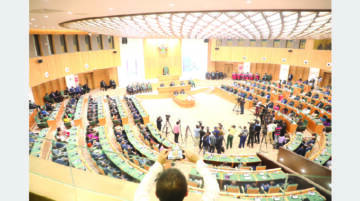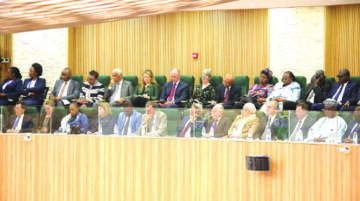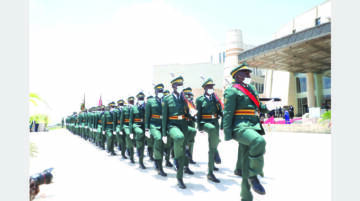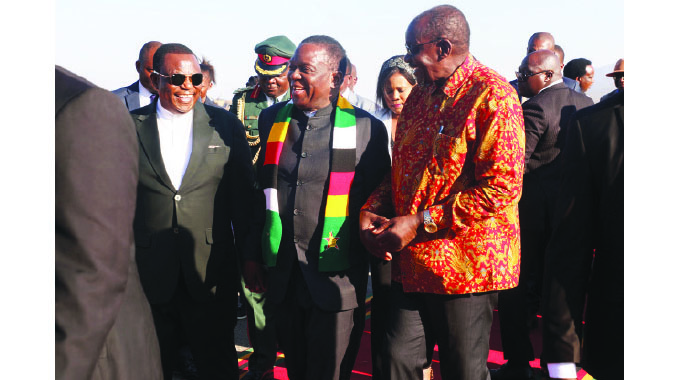New Parly Building opens grand doors to democracy

Elliot Ziwira-Senior Reporter
This session may be its last, and can be the last one for some of the parliamentarians here even, but the Ninth Parliament of Zimbabwe yesterday carved out a niche in the annals of history by becoming the first to shed the colonial baggage of (mis)representation incarnated in the old Parliament Building opposite the Africa Unity Square in Harare since the 1890s.
Indeed, there is so much hope in the gathering clouds above, so much more anticipation in the positivity of shared expectations, as the striking six-storey circular New Parliament Building in Mount Hampden, an embodiment of splendour, opens its doors to embrace true democracy, not merely representation.
Although the Ninth Parliament of Zimbabwe owns the story of legislative supremacy symbolised in the building, majestically sitting on a 70-metre platform above the picturesque surrounding area, threatening to run away with it too, the momentous occasion belongs to the man, who not only made it possible, but is also delivering the first State of the Nation Address (SONA) outside the old Parliament, shredding all that it stands for — President Mnangagwa.

Vice President Constantino Chiwenga greets Cabinet Ministers inside the New Parliament Building just before President Mnangagwa presented the State Of the Nation Address yesterday.
The official handover may be still to come, but the occasion of the opening of the 5th Session of the Ninth Parliament at Parliament’s new home in Mount Hampden, about 18km north-west of Harare along Old Mazowe Road, gives new meaning to what constitutes democracy, and how a people can fashion a shared future.
The enthusiasm, the anxiety and electric feeling that come with partaking in history making so heavily hung above the collective atmosphere that one can easily cut through it.
Used to cramming in the old Parliament building, which was converted from a hotel that went broke in the 1890s, and bought at bargain price by the British South Africa Company’s (BSAC) administrator, the legislators’ relief is palpable as they saunter in to take their maiden seats.
With Rhodies trusting in their twisted belief, spun by Ian Douglas Smith, that there would never be majority rule in “a thousand years”, the space was meant for 100 representatives; which has now become inadequate for the current 350 legislators (comprising the Senate and National Assembly), and 248 secretariat staff.
All that is in the past now!
In a democracy, citizens have an obligation to question the way they are governed and/or represented. Every citizen has a right to seek representation either in the Executive or the Legislature, which is why the New Parliament Building is crucial in reinforcing democracy.
Montesquieu (1689, 1755) puts democracy in context, thus: “As in a country of liberty, every man who is supposed to be a free agent ought to be own governor; the legislative power should reside in the whole body of the people.

Members of Parliament follow proceedings during State of the Nation Address yesterday.
“But since this is impossible in large states, and in small ones is subject to many inconveniences, it is fit the people should transact by their representatives what they cannot transact by themselves” (cited in Held, 2006: 66).
There is a telling point here; that the Legislature derives its power from “the whole body of the people” and not that it is a crucial component on its own. No!
Representative governments pervade modern politics with every country in the world having a form of parliamentary representation. There are two categories of parliamentary systems; bicameral (having two chambers of parliament), and unicameral (having one chamber or assembly).
Out of the globe’s 193 countries, 114 are unicameral and 79 are bicameral. Zimbabwe, whose parliamentary system is split into National Assembly and Senate, is bicameral.
The Althingi, the Icelandic Parliament founded in 930 AD is the oldest parliament.
If parliaments are strong they become the bedrock of democracy in global politics. Parliamentarians are the voice of their constituents, whose expectations and aspirations they carry and project in the august House, hence, they represent the people.
It is in view of the significance of the people in shaping the future and fostering development, that the Second Republic, led by President Mnangagwa, has seen to it that works on the project were commenced and finalised.
The structure comprises four floors on the Parliament side and an adjacent six-storey office building. It encompasses a Chamber House, containing the 350-seat National Assembly and 100-seat Senate, with enough space to accommodate 50 more seats in either house.
A 108-seat gallery overlooks the National Assembly, while an 84-seat gallery overlooks the Senate. There are also 24 interpreters’ rooms for both the National Assembly and the Senate; 12 for each House, which are linked to a state-of-the-art public address system.
Citizens can follow proceedings from outside through television sets in the civic square, which also provides a clearer view of the building.
Such is the nature of democracy, such also is the essence of visionary leadership.

Members of the diplomatic corps follow proceedings during the State of the Nation Address.
Legislators and visitors to the New Parliament Building are treated to breath-taking furnishings and top-notch equipment installed in the offices and chambers.
Grandeur greets the visitor from the main entrance of the superstructure, where two water fountains, inspired by one of the Seven Wonders of the World, Mosi-oa-Tunya (The Smoke that Thunders), the imposing Victoria Falls, magnificently tell the Zimbabwean story of beauty and an enduring legacy of peace.
On either side of the impressive stepladders and squares are pillars at the top of which eight Zimbabwe birds are perched.
From the ground floor to the fourth floor on the Chamber House building, and up to the fifth floor on the offices side, a comfy ambiance captures the discerning visitor’s eye.
Three bridges link the Chamber House to the office building on each of the floors from the first, second and third, making a total of nine.
Also, there are two spacious and exquisitely furnished special committee rooms, and 15 equally adorned 30-seat and 44-seat committee rooms, connected to cutting-edge conference systems.
At least 600 well-furnished rooms, among them service areas, VIP offices and directors’ offices are part of the offices section.
In addition, there are bar areas for National Assembly and Senate members, a well-equipped staff canteen, comfortably furnished dining hall, library, storerooms, and server rooms as well as public receptions on each floor.
The media, a vital cog in the wheel of democracy, is not left out, as a press studio and conference room have been included in the setup. Moreover, the building has a multi-purpose hall and facilities for other associated services. And, when complete, 800 parking bays will be available, 50 of which reserved for VVIPs.
High quality information technology, which has seen the building being installed with world-class systems for conferencing, fire-fighting, air conditioning and cooling technologies, completes the route for excellence.

Zimbabwe Defence Forces members prepare to mount a guard of honour to be inspected by President Mnangagwa at the New Parliament Building yesterday. — Pictures: Presidential photographer Joseph Nyadzayo, Justin Mutenda and Innocent Makawa.
From atop the hill upon which the edifice splendidly stands, the visitor is consumed in the serenity of the underlying environs, an expanse that stretches to the eye’s limit, creating a feeling of déjàvu that only comes with familiarity.
It is that kind of peace and tranquil which lingers on in the heart, and is therapeutic to the soul. Outside, the dreamy feeling is only interrupted by the chirping birds in the foliage beyond, and the momentary nickering of horses as man and beast share eternal camaraderie.
In the consuming mood, nature alluringly embraces humanity too.
Indeed, man has the ability to turn stone, boulder, pebble, metal, wood, water, cement and soil into infectious beauty. Joltingly, one is reminded of man’s ability to fashion out his world through sheer belief and workmanship.
Indeed, the New Parliament Building exudes the Zimbabwean spirit, culture and heritage enshrined in the Great Zimbabwe Monument, offering the motherland a chance to define itself as a nation through a homegrown plan awash with vast prospects for all citizens cutting across the entire gamut of human endeavour.









Comments